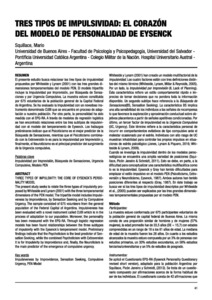Please use this identifier to cite or link to this item:
https://repositorio.uca.edu.ar/handle/123456789/9189| Título: | Tres tipos de impulsividad : el corazón del modelo de personalidad de Eysenck | Autor: | Squillace Louhau, Mario Rodolfo | Palabras clave: | IMPULSIVIDAD; SENSACION; PERSONALIDAD; Eysenck, Hans Jürgen; PSICOLOGIA; ESTUDIO DE CASOS | Fecha de publicación: | 2016 | Editorial: | Facultad de Psicología y Psicopedagogía. Universidad de Buenos Aires | Cita: | Squillace Louhau, M. R. Tres tipos de impulsividad : el corazón del modelo de personalidad de Eysenck [en línea]. Anuario de Investigaciones. 2016. ISSN: 0329-5885 . Disponible en: https://repositorio.uca.edu.ar/handle/123456789/9189 | Resumen: | Resumen:
El presente estudio busca relacionar los tres tipos de impulsividad
propuestos por Whiteside y Lynam (2001) con las tres grandes dimensiones temperamentales del modelo PEN. El modelo tripartito
incluye la Impulsividad por Imprevisión, por Búsqueda de Sensaciones y por Urgencia Compulsiva. La muestra estuvo constituida
por 675 voluntarios de la población general de la Capital Federal
de Argentina. Se ha evaluado la Impulsividad con un novedoso instrumento denominado CUBI que se encuentra en proceso de adaptación a nuestra población. Por otra parte, la personalidad ha sido
medida con el EPQ-RA. A través de modelos de regresión logística
se han encontrado relaciones entre los tres subtipos de impulsividad con el modelo del temperamento de Eysenck. Los hallazgos
preliminares indican que el Psicoticismo es el mejor predictor de la
Búsqueda de Sensaciones, mientras que el Psicoticismo combinado con la Extroversión lo es para la impulsividad por Imprevisión y,
finalmente, el Neuroticismo es el principal predictor del surgimiento
de la Urgencia compulsiva. Abstract: The present study seeks to relate the three types of impulsivity proposed by Whiteside and Lynam (2001) with the three temperamental dimensions of the PEN model. The tripartite model includes Impulsiveness by Improvidence, by Sensation Seeking and by Compulsive Urgency. The sample consisted of 675 volunteers from the general population of the Federal Capital of Argentina. Impulsiveness has been evaluated with a novel instrument called CUBI which is in the process of adaptation to our population. Moreover, the personality has been measured with the EPQ-RA. Through logistic regression models has been found relationships between the three subtypes of impulsivity with the Eysenck´s temperament model. Preliminary findings indicate that the Psychoticism is the best predictor of Sensation Seeking, while the combined Psychoticism with Extraversion it is for Impulsivity by Improvidence and, finally, the Neuroticism is the main predictor of the emergence of compulsive urgency. |
URI: | https://repositorio.uca.edu.ar/handle/123456789/9189 | ISSN: | 0329-5885 1851-1686 (online) |
Disciplina: | PSICOLOGIA | Derechos: | Acceso abierto | Fuente: | Anuario de Investigaciones. 2016 |
| Appears in Collections: | Artículos |
Files in This Item:
| File | Description | Size | Format | |
|---|---|---|---|---|
| tres-tipos-impulsividad-modelo.pdf | 1,32 MB | Adobe PDF |  View/Open |
Page view(s)
1,148
checked on Dec 24, 2025
Download(s)
577
checked on Dec 24, 2025
Google ScholarTM
Check
This item is licensed under a Creative Commons License

